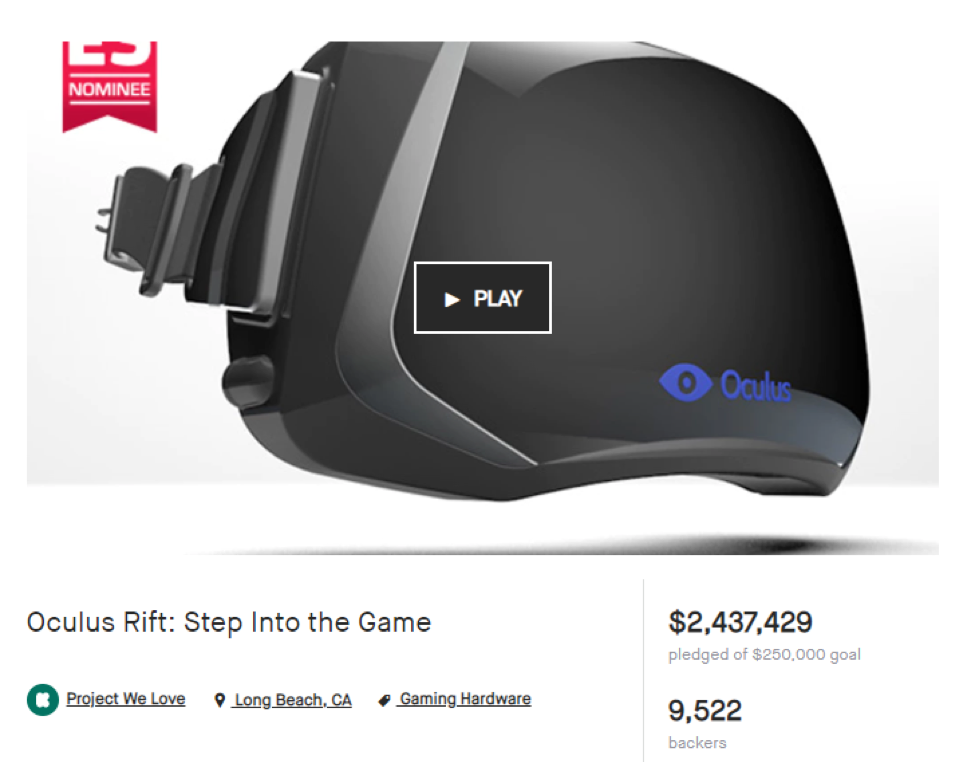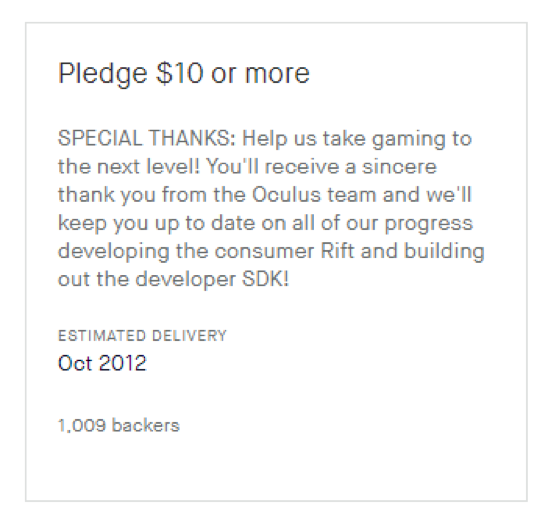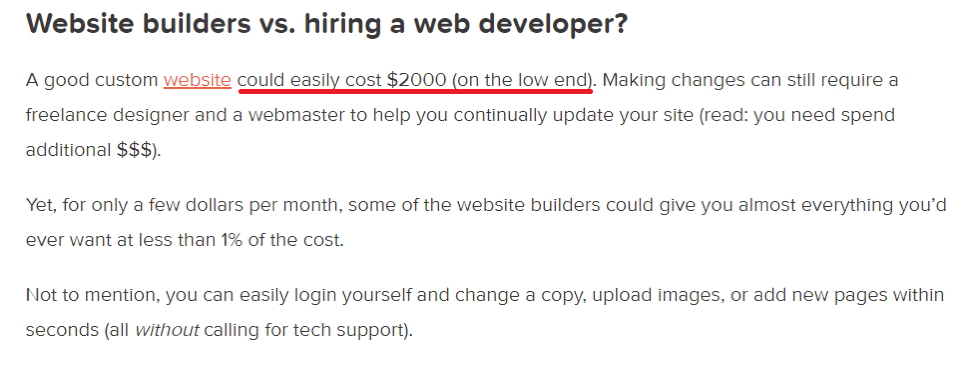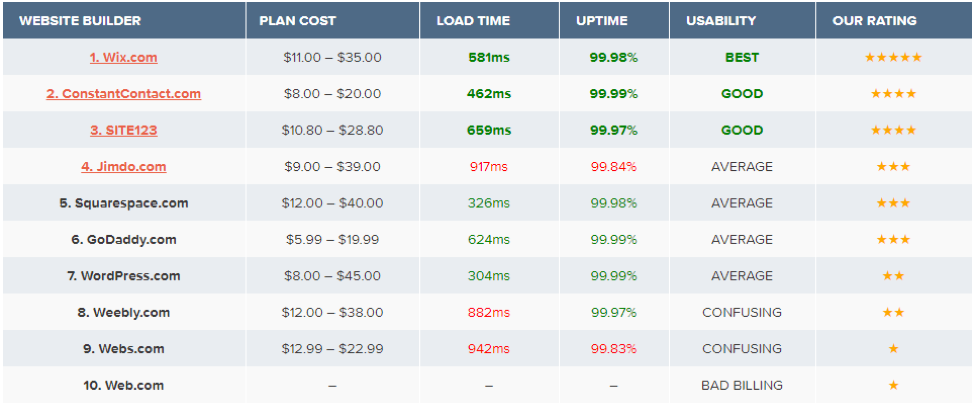Do you know that it costs five times more to acquire a new customer than it costs to retain an existing one? Or that getting your customer churn rate to reduce by just 5 percent can increase your profitability by up to 125 percent?
If you’re struggling to attain profitability with your business, or if you simply want to become a lot more profitable, it might be a good idea to start working on increasing customer loyalty.
If done right, the right use of a few cognitive biases can make a lot of difference.
#1. The IKEA Effect: People Support and Promote What They Helped Create
Facebook’s purchase of Oculus for $2 billion in March 2014 was the talk of the town, not just because of the mouthwatering amount Facebook decided to drop for Oculus but because Oculus was pretty much nonexistent just a few years back.
In fact, just two years earlier Oculus had to start a Kickstarter campaign to raise a “measly” $250,000 to fund the development of its Oculus Rift VR headsets.
So how did a company that was pretty much nonexistent go from practically begging the “crowd” for $250,000 to develop its product to being acquired by one of the biggest companies in the world in just two short years?
The answer is the IKEA effect.
Thanks to the IKEA effect, Oculus didn’t just achieve its Kickstarter funding goal but it achieved it within 24 hours and went on to achieve almost 10 times its campaign goal by the time the campaign was over.
So what is the IKEA effect and how did Oculus use it to boost customer loyalty and achieve massive valuations for a practically nonexistent brand?
Simply put, the IKEA effect is a cognitive bias in which people perceive products they helped create to be of significantly better value than identical products in which they had no involvement.
The name was derived from the approach Swedish furniture manufacturer IKEA uses, in which users have to manually assemble furniture they purchase from them.
Due to having to manually assemble IKEA furniture, research has shown that consumers believe they are far superior to similar furniture from competitors since it is their creation.
In a study on the IKEA effect, researchers divided participants into two groups and ask them to bid on furniture.
The first group was asked to assemble IKEA boxes and bid on them while the second group was asked to bid on identical IKEA boxes that had already been assembled.
The researchers found that participants who assembled their own IKEA boxes were likely to offer 62 percent more than participants bidding for the pre-assembled boxes.
Whereas participants who assembled their own boxes bid an average of $0.78, those who did not assemble the boxes bid an average of $0.48.
The study also found that participants who assembled their own boxes were more likely to rate their affection for the boxes much higher than participants that did not assemble their own boxes.
Here are some ways Oculus used the IKEA effect to boost customer loyalty:
- The community of game developers was heavily involved in the creation of the Oculus Rift
Right from the get-go, Oculus made it clear that its VR headsets were for gamers.
Unlike much bigger companies in the same industry, however, Oculus took things a step further: it didn’t just come up with VR headsets and ask gamers to use it.
It had gamers involved every step of the way in creating the Oculus Rift.
- Ordinary users were carried along in the development process
Even for users who aren’t game developers, Oculus still tried to carry its users along by allowing them to support the development by investing their funds. This was done through the Kickstarter campaign, and people were given the option to contribute as little as $10 (in return for receiving “special thanks” and being kept in the loop on development progress).
Over a thousand people did!
Thanks to Oculus’s carefully-executed campaign, one thing is clear: users felt that THEY created the Oculus Rift and supported it.
So how can this principle be used for your own business?
Here are some ideas.
- Leverage the power of user-generated content (UGC) to create content, boost your brand reach, and encourage more brand loyalty. The Share a Coke campaign by Coca-Cola is a great example; thanks to the power of UGC, it helped increase Coke’s sales in America by 2 percent and reversed a 10-year decline in Coke consumption.
- Actively involve users in product creation; before creating and rolling out new products, make sure to seek user input and clearly communicate that your products are developed based on this input.
- Actively solicit user feedback in product improvements and make it clear to users that their feedback is actually shaping product improvements.
#2. Priming Bias: Subconsciously Anchor to a Higher Price to Give the Impression of a Bargain
Take a look at the following two scenarios:
Scenario 1:
You are interested in a pair of sneakers and come across an ad.
The copy discusses the features and benefits of the sneakers and subtly mentions the fact that similar sneakers cost between $150 to $200 a few times. When it’s time to ask for the sale, you’re asked to pay $79 for the pair of sneakers.
Scenario 2:
You are interested in the same pair of sneakers above and come across an ad copy for it.
This time around, the ad copy discusses the features and benefits and tells you flat out it costs $79.
In which of the above scenarios are you more likely to buy? If psychology research is anything to go by, you’re more likely to buy in scenario 1.
In scenario 1, when the copy mentions that other sneakers cost between $150 to $200, you’re most likely expecting to pay in that range. When you eventually find out that it costs just $79, however, there’s hardly any resistance. Your immediate reaction becomes: “S*** ** and take my money!”
So why is the ad copy in scenario 1 more likely to be effective?
Because it uses a cognitive bias known as priming.
Specifically, it uses a form of priming effect known as “anchoring.” In this example, the “$150 – $200” cost serves as a reference point for you to compare the actual cost of the sneakers — in most cases, this happens subconsciously without you having an idea anything has happened.
A good real-world example comes from this comparison of website builders:
Right there in the intro of the comparison, it says that it could cost $2,000 on the low end to set up a custom website (without accounting for maintenance and updates).
Naturally, you will expect the recommended website builders to cost quite a bit… but you take a look at the price and see that it can cost as little as $5.99 and, at most, $45. You are instantly sold!
So how can you use priming to endear customers to your brand?
Here are two tips.
- Apples-to-apples comparison works best: If users realize that they are consistently able to get better deals with you as opposed to competitors offering similar products, they are likely to be more loyal to your brand.
- Always introduce the higher price first: Make sure you always introduce the higher price first; this way, the lower price is anchored to it and seen as a bargain. If you introduce the cheaper price first, it is likely to make the actual product appear expensive.
#3. The Bandwagon Effect: Nothing Attracts (and Retain) a Crowd Like a
Does the name Zachary Taylor sound familiar? If yes, that’s because he is the 12th president of the United States that a clown helped get elect.
When campaigning for president in the 19th century, Zachary Taylor enlisted the support of Dan Rice.
Rice was a famous clown and a household name at the time. During Rice’s campaign for Taylor, he used a bandwagon and made it central to his campaign by asking people to “jump on the bandwagon” to show their support for Taylor.
Taylor will eventually get elected, and “the bandwagon effect” was coined to describe a cognitive bias in which people embrace an idea not necessarily based on its merit but simply because the idea is popular.
So how can you use the bandwagon effect to boost sales and customer loyalty?
Here are 3 things to keep in mind.
- Highlight positive social proof your brand enjoys: this could be your massive brand metrics (such as user number, subscribers, traffic, etc). It could also be by regularly showcasing case studies and success stories from people using your brand offerings.
- Have an authority figure become associated with your brand: look for one or two key figures in your industry that enjoy popular appeal, and have them become brand ambassadors or look for some other way to create an association between them and your brand. This way, their popularity rubs off on your brand and the likability and loyalty they enjoy in your industry transfers to your brand.
- Leverage the power of real-time user activity to show see that people are interacting with your brand: this could be in the form of sales activity, subscriber activity, traffic numbers, social interactions, or some other key metric.
#4. Ben Franklin Effect: Use the Power of a “Small Commitment” to Get Bigger Commitments
In the 18th century, American polymath and one of the Founding Fathers, Benjamin Franklin had a rival legislator who always opposed him. Intending to win this rival legislator over, and leveraging his deep understanding of human psychology, Franklin decided to win him over.
Having learned that this rival legislator had a very scarce book in his library, he wrote him a note requesting that he do him a favor by lending him the book for just a few days.
The rival legislator lent Franklin the book, which he returned a week later with a strong sense of gratitude. When they next met in the House, this is what Franklin had to say:
“When we next met in the House, he spoke to me (which he had never done before), and with great civility; and he ever after manifested a readiness to serve me on all occasions, so that we became great friends, and our friendship continued to his death.”
Franklin would later write in his autobiography that his reason for using this particular approach was because of his understanding of the fact that: “He that has once done you a kindness will be more ready to do you another, than he whom you yourself have obliged.“
This, in essence, is the Benjamin Franklin effect.
Get people to do you a favor, or get them to make a little commitment to you, and they are likely to follow in that pattern and do even more.
So how can you use this to boost customer loyalty?
Let’s take a look at a real-world case study from superstar entrepreneur and content marketer Neil Patel.
As he was trying to boost conversions for his QuickSprout Traffic System, Patel decided to experiment with the following options:
- Selling the Traffic System without a free trial and money-back guarantee.
- Selling the Traffic System with a money-back guarantee.
- Selling the Traffic System with a 7-day free trial.
- Selling the Traffic System with a 7-day free trial and money-back guarantee.
Can you guess which of the options converted better?
The ones with the free trial.
In fact, the third and fourth option converted equally, and it didn’t really matter whether there was a money-back guarantee with the free trial.
Patel found out that double the people who would sign up when he only offered a money-back guarantee did so when he offered a free trial.
This aligned with Benjamin Franklin’s idea of getting people to make a commitment, and a similar approach can be used for your business.
Whether it is a low-commitment trial (such as charging a dollar, for example) or a free trial, you might want to experiment with free trials, or any other method that gets people to make a commitment (no matter how low), for your products and offers.
To Conclude
Implementing the above cognitive biases isn’t rocket science but, besides giving you an instant sales boost, it can go a long way to make customers loyal to your brand.











